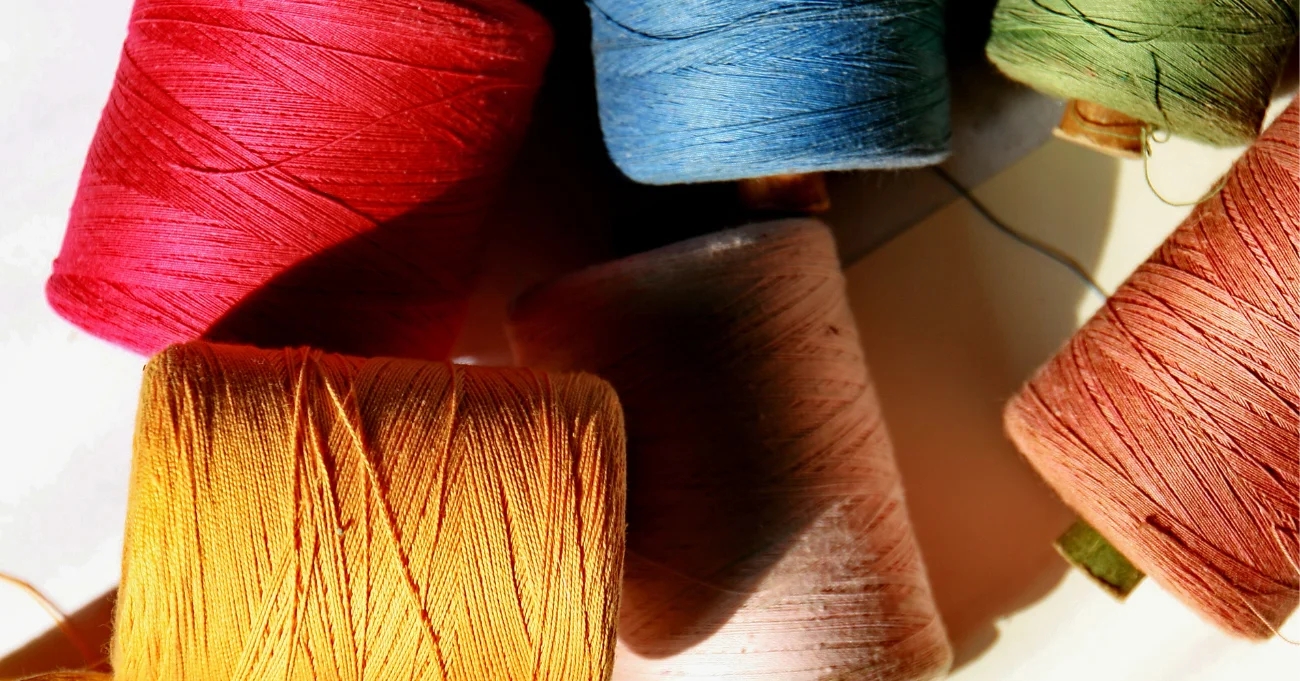Embroidery, as an art form, adds unique value to the fashion and promotional products industry. Businesses often ask, ” How long does embroidery take?” Knowing the time investment is crucial, especially when planning an embroidery project, as it can vary significantly based on the design complexity, the embroiderer’s skill level, and whether an embroidery machine or hand stitching is used.
At Scalable Press, we revolutionize the embroidery process with our cutting-edge print vendor network and modern software interfaces. Our single dashboard allows businesses to manage orders efficiently. With competitive pricing, no minimum orders, and free shipping, we offer a cost-effective, high-quality solution for companies of any size aiming for realistic and timely results.
Leveraging our experience in tailored apparel solutions, we’ve crafted this guide to help you navigate the time requirements for embroidery. We will also explore the different factors that influence embroidery time. By the end, you’ll understand the best approach to your next project, ensuring stunning designs that fit your schedule.
How long does embroidery take? Let’s find out!
Machine vs. Hand Embroidery: How Long Does Embroidery Take?
Understanding the timelines is key when deciding between machine and hand embroidery. Each method brings distinct advantages, but the time required can vary significantly. So, how long does embroidery take? Let’s delve into the time differences between machine and hand embroidery to help you choose the best option.
What is Machine Embroidery?
Machine embroidery is a method that uses a sewing machine to create detailed designs on fabric. It refers to the use of automated machines to complete embroidery tasks, making it accessible to beginners and experienced crafters alike. This technique is perfect for those who want a rewarding craft without investing much time. Businesses, hobbyists, and crafters benefit from the speed of the machine, allowing for the quick production of logos and simple designs.
Types of Embroidery Machines
Embroidery machines come in various types, each offering unique features and capabilities. Understanding these machines helps determine the time required for embroidery and selecting the right one for specific projects.
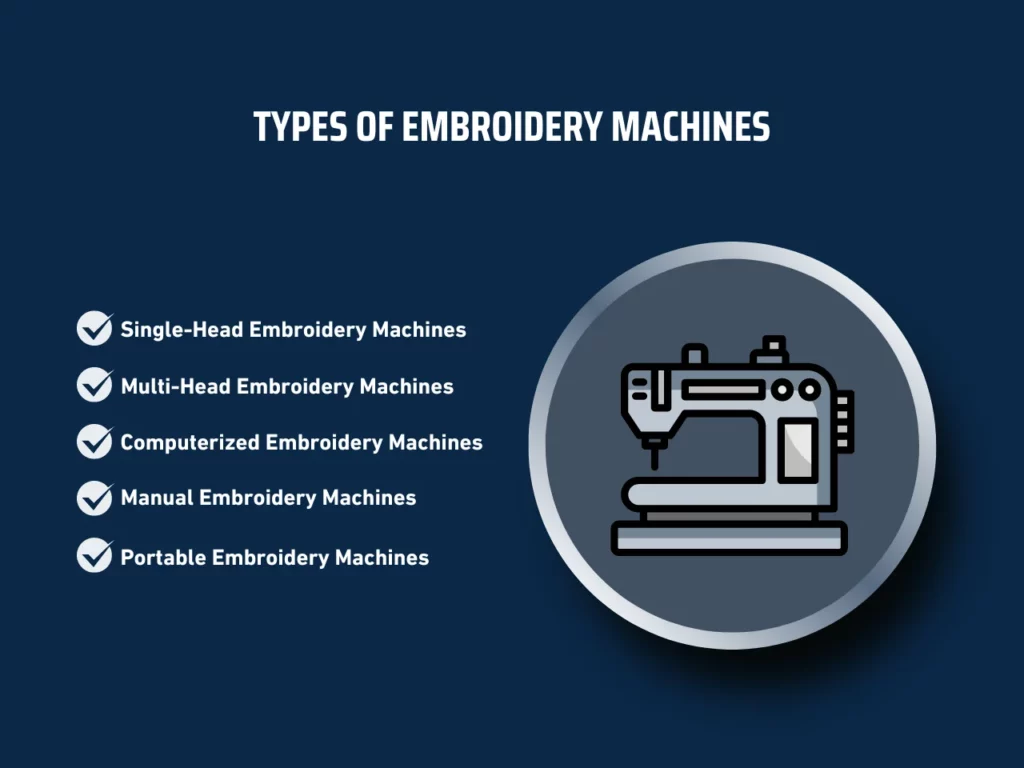
- Single-Head Embroidery Machines: These are for smaller operations or businesses that handle custom orders. These machines have one head that works on a single garment at a time. The duration of the embroidery process varies based on the design’s complexity.
- Multi-Head Embroidery Machines: It has multiple heads, allowing simultaneous embroidery on several garments. Ideal for larger orders, these machines significantly reduce the embroidery time frame, making them efficient for bulk production.
- Computerized Embroidery Machines: These machines use digital designs to automate embroidery. They offer precision and speed, making them suitable for intricate designs. Due to automated features, the embroidery project time estimate is often shorter.
- Manual Embroidery Machines: These machines require more skill and time to produce designs. While less common in modern industries, they are still used for specific projects where hands-on control is preferred.
- Portable Embroidery Machines: These machines are small and lightweight for on-the-go projects or small-scale operations. While convenient, the time required for embroidery with these machines may be longer than larger, more powerful options.
The chosen type of embroidery machine directly influences the time required for embroidery and the efficiency of the production process. Understanding these machines’ capabilities helps make informed decisions, ensuring the time estimate aligns with business needs and deadlines.
How Long Does Machine Embroidery Take?
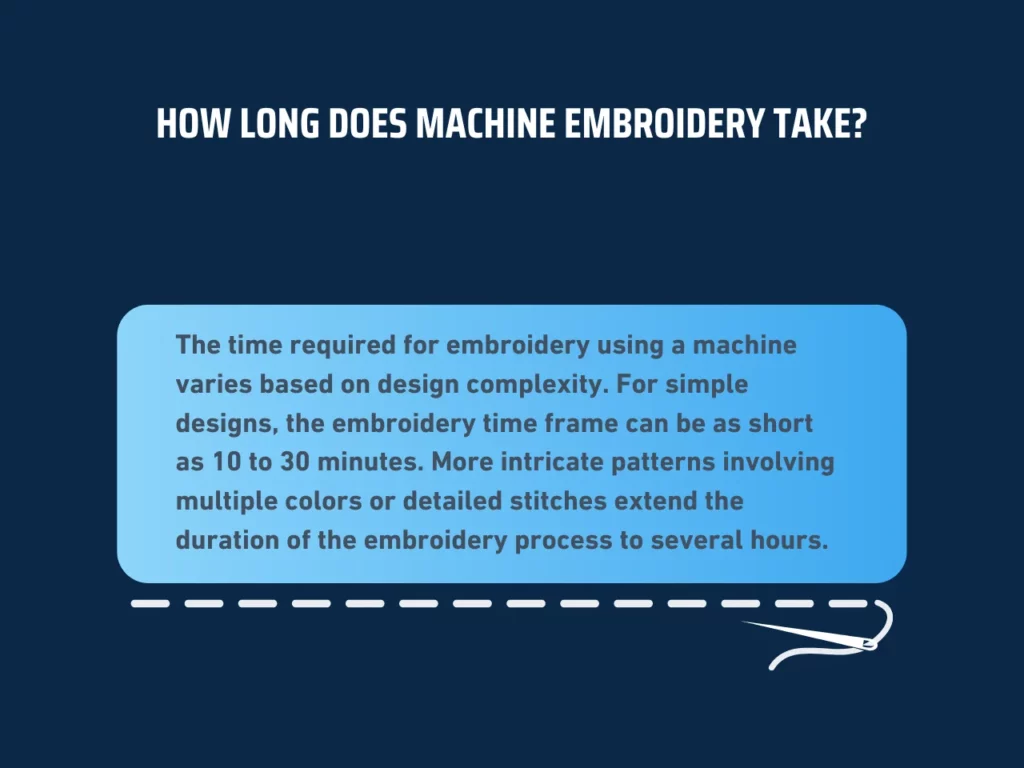
The time required for embroidery using a machine varies based on design complexity. For simple designs, the embroidery time frame can be as short as 10 to 30 minutes. More intricate patterns involving multiple colors or detailed stitches extend the duration of the embroidery process to several hours.
In general, estimating the time for a straightforward embroidery project with machines is quicker than hand embroidery. Efficient machines and experienced operators can significantly reduce the overall time. Understanding these factors helps businesses plan and meet their project deadlines effectively.
Factors Affecting Time in Machine Embroidery
Understanding the factors that impact the time required for embroidery is crucial for managing deadlines and expectations. Machine embroidery offers efficiency, but several elements can affect the overall embroidery time frame.
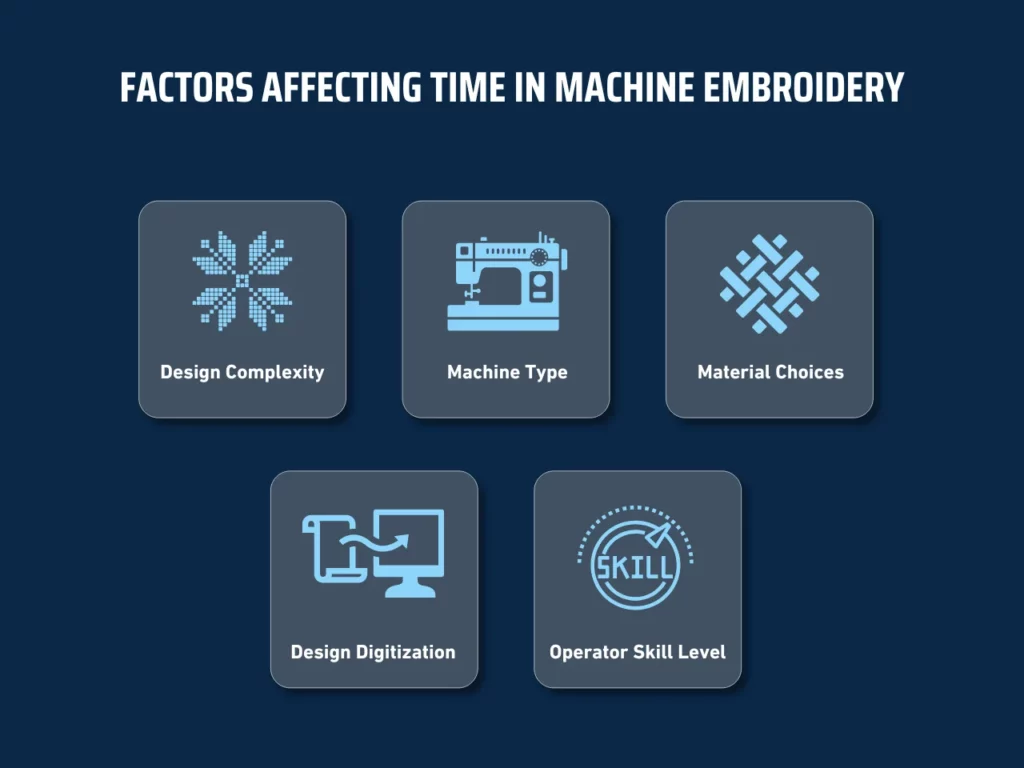
- Design Complexity: The more intricate the design, the longer the embroidery project time estimate. Complex patterns with detailed stitching or multiple colors increase the duration of the embroidery process.
- Machine Type: Different machines operate at different speeds. Single-head machines take longer for larger orders, while multi-head machines complete multiple pieces simultaneously, reducing the time frame.
- Material Choices: The type of fabric and thread used can impact the time required for embroidery. Dense or textured fabrics like denim or velvet require slower stitching speeds, extending the embroidery project time estimate.
- Design Digitization: It is critical to convert a design into a digital format suitable for machine embroidery. Complex digitization can extend embroidery, especially for detailed logos or intricate artwork.
- Operator Skill Level: Skilled operators reduce setup and adjustment times, leading to a shorter time frame. Experience allows for quicker troubleshooting and efficient machine operation.
Several factors influence the time required for embroidery using machines. Design complexity, machine efficiency, thread management, operator skill, and order size all play a role in determining the time estimate. Understanding these factors helps businesses plan their time frame more effectively, ensuring the timely completion of projects.
What is Hand Embroidery?
Hand embroidery is a traditional technique where each stitch is made manually, allowing for the creation of intricate designs. This method is ideal for smaller projects and offers a personal touch to each embroidery project. The complexity of the design can vary, making it suitable for those with different levels of embroidery skill. Beginners and seasoned hobbyists enjoy hand embroidery’s creative freedom, making it a rewarding hobby that requires patience and dedication.
Common Hand Embroidery Techniques
Hand embroidery involves various techniques, each offering distinct styles and effects. These techniques require different skill levels and time, impacting the time required for embroidery.
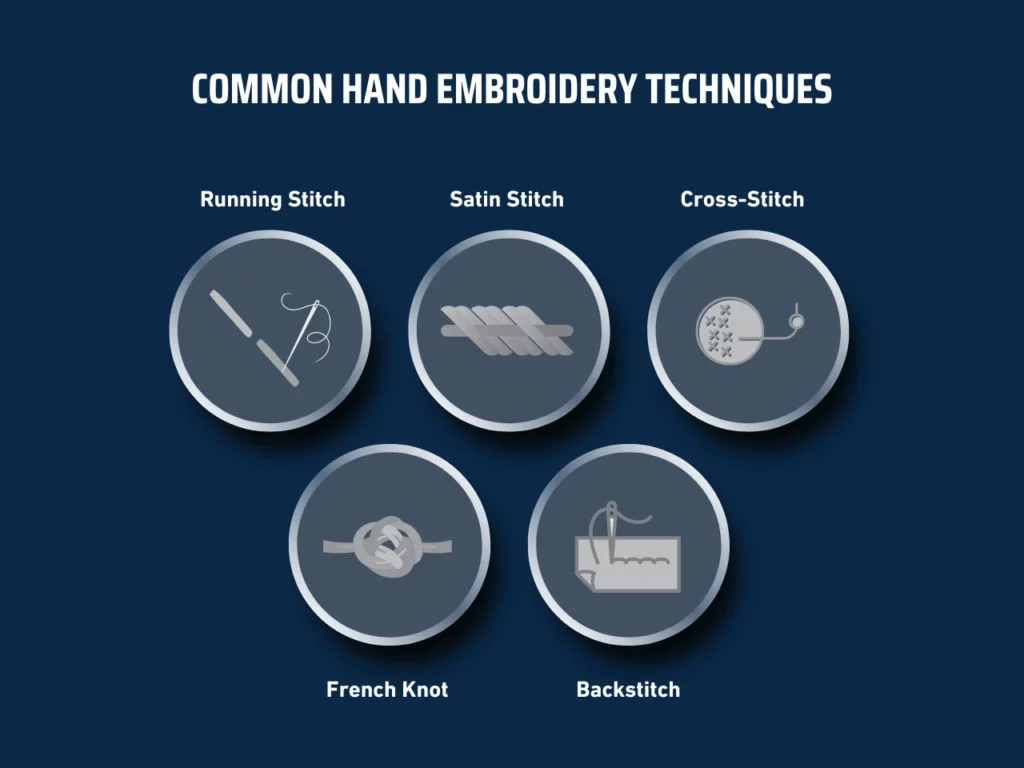
- Running Stitch: The most basic and commonly used stitch in hand embroidery. It involves making small, even stitches in a straight line. The embroidery process for running stitches is generally short, making it ideal for simple outlines and borders.
- Satin Stitch: A technique used to fill in shapes with smooth, even stitches. It requires precision to ensure the stitches lay flat and completely cover the fabric. This stitch takes longer, extending the embroidery time frame for more detailed designs.
- Cross-Stitch: Popular for creating intricate patterns and images, cross-stitch involves making X-shaped stitches on a grid. Depending on the pattern’s complexity, this technique can be time-consuming, affecting the embroidery project time estimate.
- French Knot: This decorative stitch creates small, raised dots on the fabric. It adds texture and detail to designs. Although it’s a small stitch, it can be time-consuming, particularly when used extensively in a design, impacting the time required for embroidery.
- Backstitch: Strong and durable, the backstitch outlines and adds detail to designs. It creates a continuous line of stitches and is often used for text and fine lines. The duration of the embroidery process for backstitch is moderate, depending on the design’s complexity.
These hand embroidery techniques vary in the time required, so it is essential to choose the right method based on the project’s requirements and timeline.
How Long Does Hand Embroidery Take?
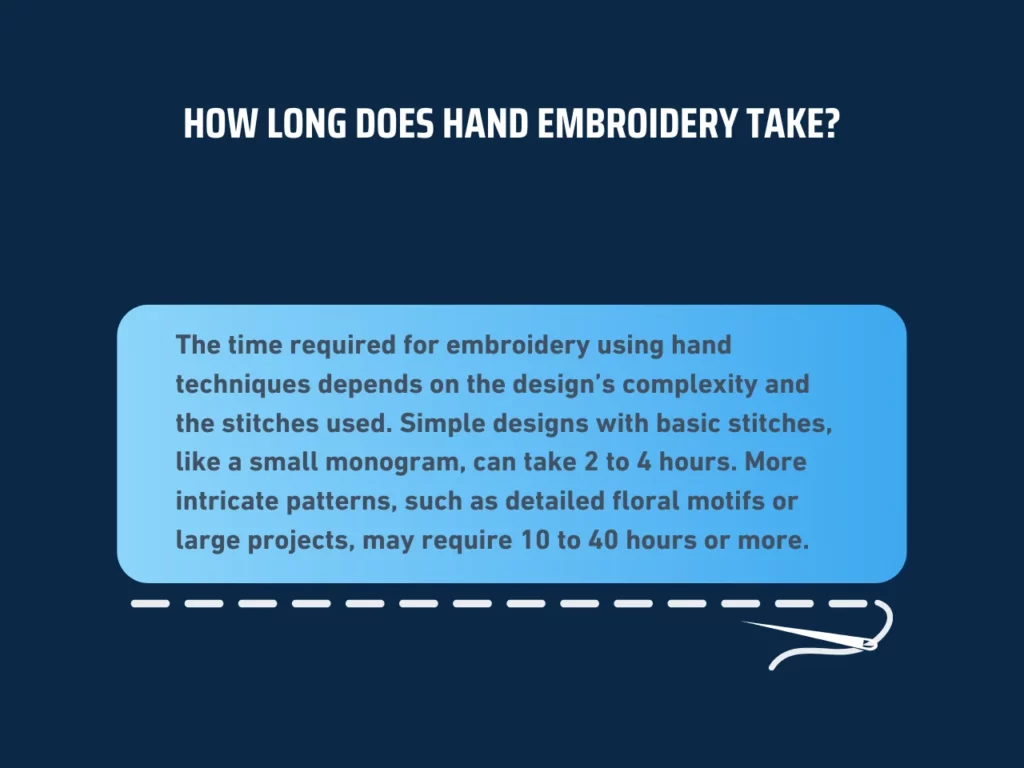
The time required for embroidery using hand techniques depends on the design’s complexity and the stitches used. Simple designs with basic stitches, like a small monogram, can take 2 to 4 hours. More intricate patterns, such as detailed floral motifs or large projects, may require 10 to 40 hours or more.
The embroidery process is significantly longer than that of machine methods. A detailed project time estimate for complex hand embroidery can extend over several days, depending on the embroiderer’s skill level and the embroidery time frame needed for each specific project.
Factors Affecting Time in Hand Embroidery
Hand embroidery is a detailed and time-consuming craft. Several factors influence the time required for embroidery when done by hand, impacting the overall duration of the embroidery process.
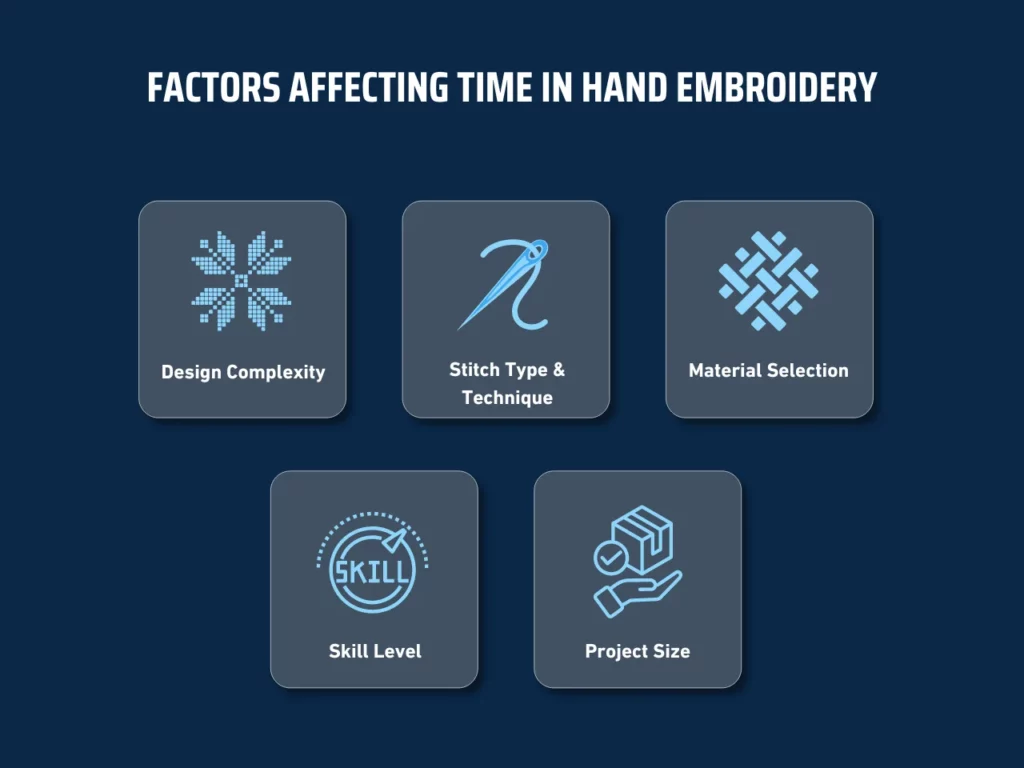
- Design Complexity: Intricate designs with fine details require more time, increasing the embroidery project time estimate. Simple designs with fewer elements can be completed more quickly.
- Stitch Type and Technique: Different stitches take varying amounts of time. Techniques like a satin stitch or French knots take longer than basic running stitches, affecting the time frame.
- Material Selection: The choice of fabric and thread impacts the time required for embroidery. Delicate or textured fabrics may require slower, more careful stitching, extending the duration of the process.
- Embroiderer’s Skill Level: Experienced embroiderers work faster and more efficiently, reducing the time frame. Less experienced crafters may take longer to achieve the desired quality.
- Project Size: Larger projects naturally increase the project time estimate. Small, focused designs can be completed quickly, while larger pieces demand more work hours.
The time required for hand embroidery varies significantly based on several factors. Design complexity, stitch type, material choice, skill level, and project size all influence the duration of the embroidery process. Understanding these elements helps manage expectations and ensures a realistic time frame for any project.
Tips for Reducing Embroidery Time
Reducing embroidery time is crucial for meeting tight deadlines, especially for businesses that rely on quick turnarounds. Whether working with machines or hand embroidery, optimizing processes can save valuable time while maintaining quality.
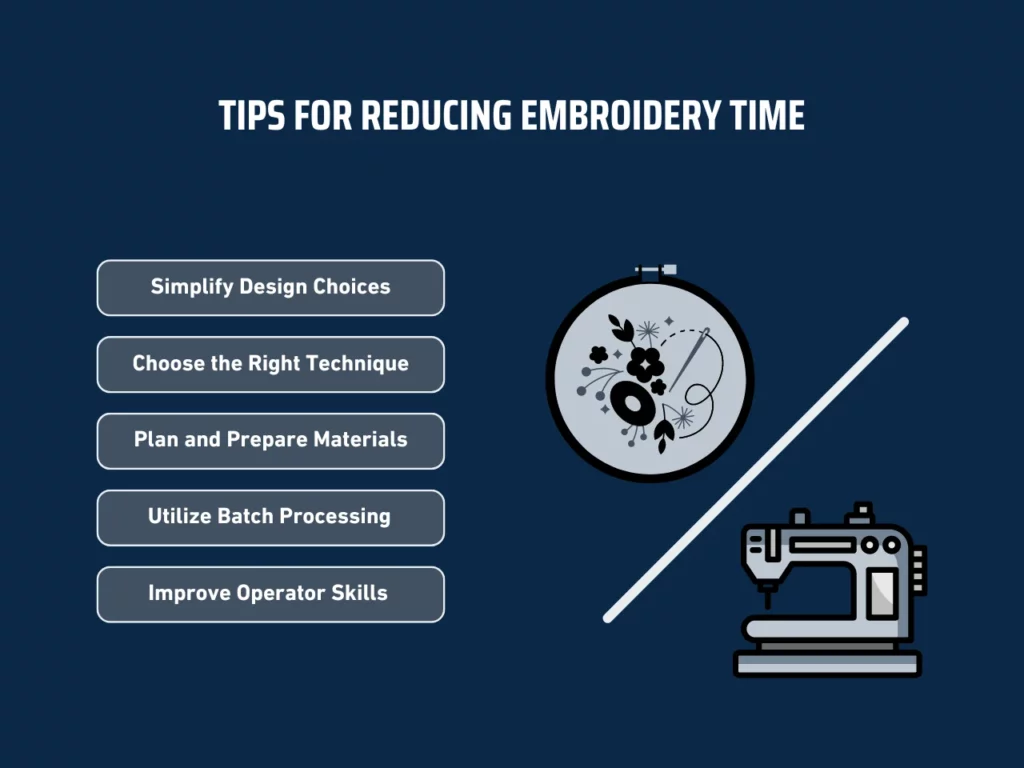
Here are five effective tips to help minimize the time required for embroidery projects.
1. Simplify Design Choices
One of the most effective ways to reduce embroidery time is to simplify design elements. Opt for fewer colors, less intricate patterns, and straightforward designs. Simplified designs result in fewer stitches, speeding up machine and hand embroidery. This approach works well for promotional items where time efficiency is a priority.
2. Choose the Right Technique
Selecting the appropriate embroidery technique for the project is essential. Machine embroidery often offers faster results for large orders or complex designs. Hand embroidery, while slower, suits smaller, detailed projects where craftsmanship matters. Assessing the project’s requirements and choosing the best method ensures time efficiency.
3. Plan and Prepare Materials
Proper planning and material preparation significantly reduce embroidery time. Before starting, make sure all threads, fabrics, and tools are organized and ready to go. For machine embroidery, ensure the design is digitized, and the machine is correctly set up. For hand embroidery, pre-organizing threads and marking patterns on fabric will streamline the workflow.
4. Utilize Batch Processing
Batch processing involves completing multiple items in one go, which saves time on repeated tasks. For businesses, this means setting up the machine to handle several pieces consecutively or preparing multiple hand embroidery projects in advance. This approach reduces the time spent on setup and transitions between tasks.
5. Improve Operator Skills
Skill level directly impacts how long embroidery takes. Investing in training for machine operators or hand embroiderers improves efficiency. Skilled operators can handle more complex designs faster and troubleshoot issues quickly, reducing overall production time. Continuous learning and practice lead to faster, more precise work.
Key Takeaway
Machine embroidery generally offers quicker turnaround times than hand embroidery. When evaluating how long does embroidery take, it’s important to consider the complexity and quality requirements of your project. Due to its efficiency, machine embroidery is often preferred for large orders or intricate designs. However, hand embroidery provides a distinctive, artisanal touch that may be worth the additional time for certain projects.
Choosing between machine and hand embroidery also hinges on your timeline and budget. Contract embroidery pricing can differ widely, with machine embroidery often being more cost-effective for bulk orders. Understanding how long does embroidery take will help you make informed decisions, ensuring your project meets deadlines without compromising on quality. Additionally, knowing how to digitize for embroidery can streamline the process, reducing production time.
Are you curious about how to keep your hat embroidery fresh and vibrant? At Scalable Press, we provide expert tips and insights to help you maintain the quality of your embroidered products. Explore our product catalog to learn more about our embroidery options and services.
